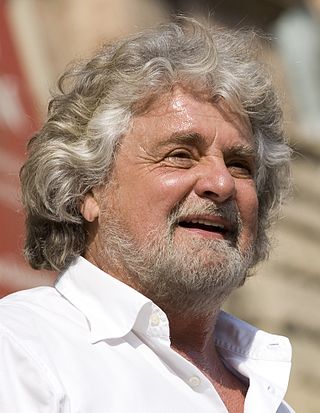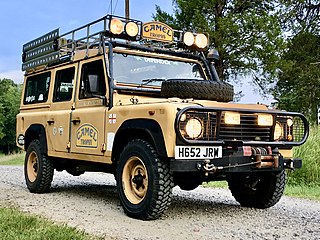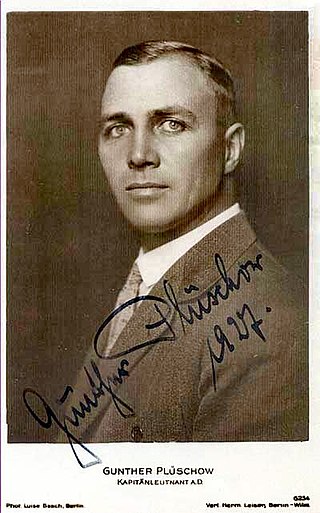
Tierra del Fuego is an archipelago off the southernmost tip of the South American mainland, across the Strait of Magellan.

The Strait of Magellan, also called the Straits of Magellan, is a navigable sea route in southern Chile separating mainland South America to the north and Tierra del Fuego to the south. The strait is considered the most important natural passage between the Atlantic and Pacific oceans. The strait is approximately 570 km long and 2 km wide at its narrowest point. In 1520, the Spanish expedition of the Portuguese navigator Ferdinand Magellan, after whom the strait is named, became the first Europeans to discover it.

A serac is a block or column of glacial ice, often formed by intersecting crevasses on a glacier. Commonly house-sized or larger, they are dangerous to mountaineers, since they may topple with little warning. Even when stabilized by persistent cold weather, they can be an impediment to glacier travel.

Rai 1 is an Italian free-to-air television channel owned and operated by state-owned public broadcaster RAI – Radiotelevisione italiana. It is the company's flagship television channel, and is known for broadcasting mainstream and generalist programming, usually aimed towards families, including TG1 news bulletins, prime time drama, cinema and entertainment, and major breaking news, sports and special events.

Giuseppe Piero "Beppe" Grillo is an Italian comedian, actor, blogger, and politician.

Julius Popper, known in Spanish as Julio Popper, was a Romanian-born Argentine engineer, adventurer, and explorer. He was known as a modern "conquistador" of Tierra del Fuego in southern South America, and was both a controversial and influential figure. Popper was one of the main perpetrators of the genocide against the native Selk'nam people in the islands, and the circumstances surrounding his own death remain a mystery.

Camel Trophy was an off-road vehicle-oriented competition that was held annually between 1980 and 2000. It was best known for its use of Land Rover vehicles over challenging terrain. Occasionally called "The Olympics of 4x4", the event took its name from its main sponsor, the Camel cigarette brand.

Cape Horn is the southernmost headland of the Tierra del Fuego archipelago of southern Chile, and is located on the small Hornos Island. Although not the most southerly point of South America, Cape Horn marks the northern boundary of the Drake Passage and marks where the Atlantic and Pacific Oceans meet.

Gunther Plüschow was a German aviator, aerial explorer, and author from Munich, Bavaria. His feats include the only escape by a German prisoner of war in either world war from Britain back to Germany; he was the first man to explore and film Tierra del Fuego and Patagonia from the air. He was killed on a second aerial expedition to Patagonia in 1931. As an aviator and explorer, he is honored as a hero by the Argentine Air Force to this day.

Long Way Down is a television series and book documenting a motorcycle journey undertaken in 2007 by Ewan McGregor and Charley Boorman, from John o' Groats in Scotland through eighteen countries in Europe and Africa to Cape Town in South Africa. It is a follow-up to the Long Way Round of 2004, when the pair rode east from London to New York via Eurasia and North America.

Top Gear: Polar Special, also known as the Polar Challenge, is a special edition episode of BBC motoring programme Top Gear that was first broadcast on 25 July 2007 on BBC Two. The episode follows presenters Jeremy Clarkson and James May in their successful attempt to be the first people to reach the 1996 position of the North Magnetic Pole in a motor vehicle. They did not, however, reach the actual position of the North Magnetic Pole at the time which in 2007 was 150 miles away. They were also 1200 miles away from the geographical North Pole. For added drama and competition, they raced against presenter Richard Hammond who travelled by dog sled, the traditional means of transport around the Arctic. This was the first episode ever aired in HDTV.

Charles Wellington Furlong (1874–1967) was an American explorer, writer, artist and photographer from Massachusetts.

Carlo Mauri was an Italian mountaineer and explorer. Mauri was born in Lecco. Among his early climbs in the Alps two stand out: the first winter ascent of the via Comici route on the northern face of Cima Grande di Lavaredo; and the first solitary ascent of the Poire of Mont Blanc. Numerous expeditions abroad followed. In 1956 he reached the summit of Monte Sarmiento in Tierra del Fuego and in 1958, as a member of Riccardo Cassin’s expedition in Karakorum, he and Walter Bonatti made the first ascent of Gasherbrum IV.

Overlanding or 4WD Touring is self-reliant overland travel to remote destinations where the journey is the principal goal. Typically, but not exclusively, it is accomplished with mechanized off-road capable transport where the principal form of lodging is camping, often lasting for extended lengths of time and spanning international boundaries.

Kevin Sanders and Julia Sanders are an English motorcyclist husband and wife noted for overland long-distance riding. They hold two Guinness World Records. The first was achieved in June 2002 by circumnavigating the world by motorcycle in 19½ days. The second was completed on 22 September 2003, riding the length of the Americas from Deadhorse, Prudhoe Bay in Alaska, United States to Ushuaia, Tierra del Fuego, Argentina in 35 days and breaking the previous record by over 12 days. After these Guinness World records, they founded their motorcycle expedition company, GlobeBusters Motorcycle Expeditions in 2004.
VIAC, the VisLab Intercontinental Autonomous Challenge, is the challenge conceived by VisLab as an extreme test of autonomous vehicles. It ran from July 20, 2010 to October 28, 2010, involving four driverless vehicles driving with virtually no human intervention on an almost 16,000 kilometres (9,900 mi) trip from Parma, Italy to Shanghai, China.
Helge Pedersen is a long-distance motorcyclist originally from Kristiansand, Norway, who now resides in Seattle, Washington. He traveled more than 250,000 miles (400,000 km) touring the world on a BMW R80G/S adventure touring motorcycle between 1982 and 1992. This journey is recounted in his book 10 Years on 2 Wheels. The motorcycle he rode on was placed on display at the BMW Museum in Munich.
Lois Pryce is a British author, journalist and a founder/curator of the Adventure Travel Film Festival. She is the author of Lois on the Loose, Red Tape & White Knuckles and Revolutionary Ride, travel memoirs about her solo motorcycle journeys through the Americas, Africa and Iran.

Helen (Armstrong) Schreider and Frank Schreider were explorers in the mid-20th century, known for traveling by amphibious jeep. National Geographic hired them after their first independent journey from Alaska to Tierra del Fuego (1954–56). They were the first people to travel the length of the Americas solely by means of their own power. They completed six additional expeditions through National Geographic, working freelance at first and later as foreign editorial staff, for fifteen years, from 1956 to 1970. They worked as a team and lived for periods of time in about 50 countries on five continents. Helen and Frank Schreider were known for their ability to write, photograph and film within the cultures they visited. They wrote three books, six major articles for National Geographic, and contributed to nine other books. They also made three separate nationwide speaking tours with their films.
















